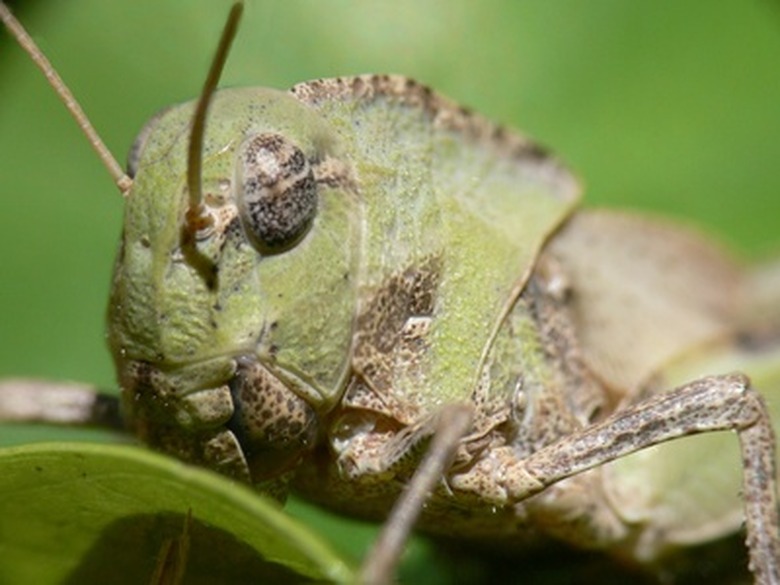How Do Grasshoppers Communicate?
Grasshoppers are insects with two pairs of wings, strong hind legs and chewing mouth parts also known as mandibles. They go through "incomplete metamorphosis," in which each stage looks similar but adds a few changes each time they shed. The female is usually larger, while the male frequently has brightly colored wings he uses to attract mates and warn off predators. These herbivores use visual and acoustic cues to communicate, as well as scent and touch.
Environment
Grasshoppers are commonly found in dryer habitats such as deserts and fields but can also be found in forests, wetlands and even tropical jungles. It is important to find a location with convenient food sources, access to warmth and little local competition to ensure the survival of as many young as possible. The only care grasshoppers give their young after finding a convenient location to lay their eggs is burying them in the ground and covering them in a waterproof foam eggpod.
- Grasshoppers are insects with two pairs of wings, strong hind legs and chewing mouth parts also known as mandibles.
- The female is usually larger, while the male frequently has brightly colored wings he uses to attract mates and warn off predators.
Behavior
Grasshoppers prefer warm climates. The adults usually die during winter in colder climates, although they have been observed to live years in warmer tropical areas. They tend to sleep as temperatures cool during the night, becoming active as the temperature rises with the sun. Their characteristic jumping and flying are behavioral patterns and tend to be mimicked by grasshoppers of different species in a particular area–whereas, grasshoppers even a mile away will have different behavioral patterns, according to the "Field Guide to Common Western Grasshoppers," by Robert E. Pfadt. Grasshoppers are usually solitary, migrating insects that do not form nests or have territories. At times when food is difficult to find, these herbivores may sometimes join to form a swarm that can cover many square miles and eat every green plant in the area. Grasshoppers that do this are known as locusts or Acrididae. Except for a few brightly colored grasshoppers that store poison digested from plants within their bodies for protection, spitting up "tobacco juice," a staining brown liquid, appears to be their only form of self-defense.
- Grasshoppers prefer warm climates.
- Their characteristic jumping and flying are behavioral patterns and tend to be mimicked by grasshoppers of different species in a particular area–whereas, grasshoppers even a mile away will have different behavioral patterns, according to the "Field Guide to Common Western Grasshoppers," by Robert E. Pfadt.
Reproduction and Development
Males of some species of grasshopper vibrate their wings, making a sound known as stridulation that attracts females to mate with them. Females respond by "presenting," conveniently positioning their abdomen and hindlegs. Mating usually occurs in the fall in temperate regions, after which the female lays an eggpod filled with multiple eggs, each with an embryo and a nutrient-filled yolk. The embryos' development depends on the warmth of the soil in the next few weeks. If the temperature isn't high enough, eggs can become dormant. Some embryos survive the winter, but it depends on the level of growth attained before the frost. Infant grasshoppers closely resemble adults, but they are much smaller and lack wings, which they gain after several molts.
- Males of some species of grasshopper vibrate their wings, making a sound known as stridulation that attracts females to mate with them.
- Some embryos survive the winter, but it depends on the level of growth attained before the frost.
Auditory Organs and Singing
Short-horned grasshoppers have "auditory organs," or ears, located on the first abdominal segment, which is basically the chest. A comb-like structure on the inside of the hind leg is rubbed by a wing ridge to produce a "chirping" sound. Long-horned grasshoppers have ears in the knee-joints of their front legs. They also have a comb-and-ridge mechanism but the sound is produced by rubbing the forewings against each other. Some species also use vibrations and touch to find each other. The males tap on leaves of a particularly tasty plant and a female will tap back.
Communication
Grasshoppers have complicated visual and acoustic languages. Each species produces its own unique sound. They use their hindlegs and wings to flash visual messages as well as to produce sounds. They also "talk" by rubbing their legs against the tegmina (sides of the abdomen) and by "crepitation," which is snapping their hindwings while flying. Grasshoppers have large compound eyes that are helpful in reading these complicated messages. It is undocumented whether the young grasshoppers' lack of wings affects their ability to communicate. Species that do not sing use pheromones to attract mates.
- Short-horned grasshoppers have "auditory organs," or ears, located on the first abdominal segment, which is basically the chest.
- A comb-like structure on the inside of the hind leg is rubbed by a wing ridge to produce a "chirping" sound.
